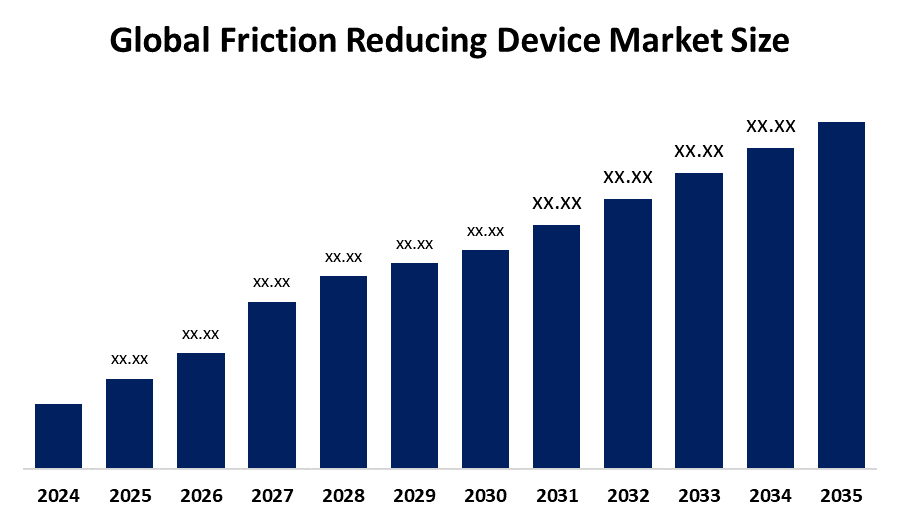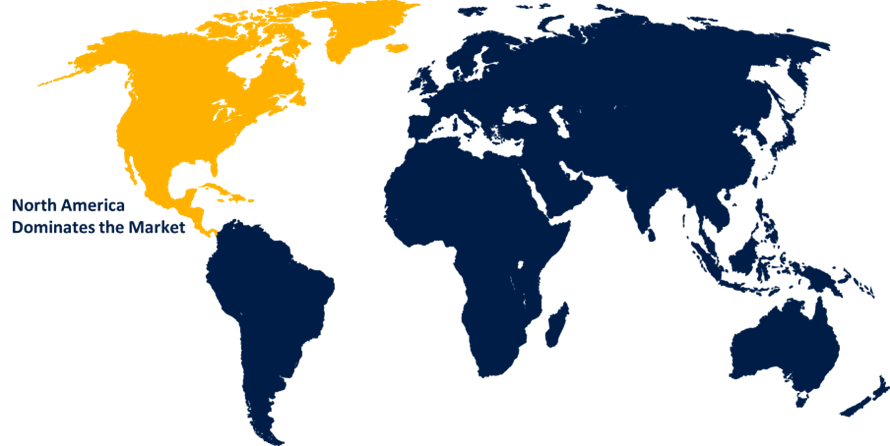Global Friction Reducing Device Market Size, Share, and COVID-19 Impact Analysis, By Type (Synthetic Friction Reducers, Organic Friction Reducers, and Combination Friction Reducers), By Application (Hydraulic Fracturing, Drilling Fluids, Stimulation Fluids, Cementing Fluids, Well Stimulation, and Enhanced Oil Recovery (EOR)), and By Region (North America, Europe, Asia-Pacific, Latin America, Middle East, and Africa), Analysis and Forecast 2025 - 2035
Industry: Chemicals & MaterialsGlobal Friction Reducing Device Market Insights Forecasts to 2035
- The Global Friction Reducing Device Market Size is Expected to Hold a Significant Share by 2035, at a CAGR of 5.6%
- Asia Pacific is Expected to Grow the Fastest During the forecast period.

Get more details on this report -
The Global Friction Reducing Device Market Size is Expected to Hold a Significant Share by 2035, at a CAGR of 5.6% during the forecast period 2025-2035. Growth in oil and gas exploration, increased need for energy-efficient solutions, improvements in polymer formulation technology, and the increasing use of environmentally and biodegradable-friendly friction reducers are all factors contributing to the friction-reducing devices market.
Market Overview
The global industry devoted to the creation, manufacturing, and use of mechanical solutions and chemical additives intended to reduce friction between moving surfaces is known as the friction reducing device market. These devices are essential for lowering energy consumption and prolonging the life of machinery and equipment in a variety of industries, such as manufacturing, automotive, aerospace, and oil & gas. The market for friction-reducing devices is focused on improving operational efficiency through the reduction of friction between moving surfaces, which lowers energy consumption, wear and tear, and maintenance expenses in a variety of industrial applications.
The market for friction-reduction devices is being driven by the increasing demand for more efficient oil and gas extraction since these additives allow for higher flow rates and lower pumping pressures by minimizing friction between the fracturing fluid and the wellbore. Growing focus on sustainable and biodegradable solutions, technological developments in polymer compositions, and rising demand for energy-efficient systems are driving the friction reducing device market.
Report Coverage
This research report categorizes the friction reducing device market based on various segments and regions, forecasts revenue growth, and analyzes trends in each submarket. The report analyses the key growth drivers, opportunities, and challenges influencing the friction reducing device market. Recent market developments and competitive strategies such as expansion, type launch, development, partnership, merger, and acquisition have been included to draw the competitive landscape in the market. The report strategically identifies and profiles the key market players and analyses their core competencies in each sub-segment of the friction reducing device market.
Global Friction Reducing Device Market Report Coverage
| Report Coverage | Details |
|---|---|
| Base Year: | 2024 |
| Forecast Period: | 2024-2035 |
| Forecast Period CAGR 2024-2035 : | 5.6% |
| Historical Data for: | 2020-2023 |
| No. of Pages: | 240 |
| Tables, Charts & Figures: | 160 |
| Segments covered: | By Type, By Application and By Region. |
| Companies covered:: | BASF SE, Solvay S.A., Clariant AG, Ashland Inc., Japan Drilling Co, Halliburton Company, Chevron Corporation, National Oilwell Varco, SNF Holding Company, Nabors Industries Ltd., Schlumberger Limited, Baker Hughes Company, ConocoPhillips Company, Weatherford International and Others. |
| Pitfalls & Challenges: | COVID-19 Empact,Challenges, Future, Growth, & Analysis |
Get more details on this report -
Driving Factors
The market for friction-reducing devices is further driven by the growing use of horizontal drilling and multi-stage fracturing techniques, particularly in shale-rich areas like the Marcellus Shale in the United States. The growing need for energy-efficient solutions, the expanding use of hydraulic fracturing, and the growing consciousness of sustainable practices are the main factors propelling the friction reducing device market. Friction reducer usage has been greatly accelerated by the growth of horizontal drilling and hydraulic fracturing, especially in shale-rich areas. Furthermore, rising industrial infrastructure in emerging economies and a greater focus on lowering equipment wear and maintenance costs are driving friction reducing device market.
Restraining Factors
Variable raw material costs, strict environmental laws, a lack of knowledge in developing nations, and difficulties with compatibility with different lubricants and coatings are some of the major factors restraining the friction reducing devices market.
Market Segmentation
The friction reducing device market share is classified into type and application.
- The synthetic friction reducers segment dominated the market in 2024 and is projected to grow at a substantial CAGR during the forecast period.
Based on the type, the friction reducing device market is divided into synthetic friction reducers, organic friction reducers, and combination friction reducers. Among these, the synthetic friction reducers segment dominated the market in 2024 and is projected to grow at a substantial CAGR during the forecast period. The synthetic friction reducers segment is credited with its exceptional performance, thermal stability, and suitability for a variety of industrial fluids, especially those used in gas and oil applications. Synthetic friction reducers are the go-to option in many industries due to they consistently produce results even under the most demanding working situations.
- The hydraulic fracturing segment accounted for the largest share in 2024 and is anticipated to grow at a significant CAGR during the forecast period.
Based on the application, the friction reducing device market is divided into hydraulic fracturing, drilling fluids, stimulation fluids, cementing fluids, well stimulation, and enhanced oil recovery (EOR). Among these, the hydraulic fracturing segment accounted for the largest share in 2024 and is anticipated to grow at a significant CAGR during the forecast period. The oil and gas industry's increasing need for effective extraction techniques, especially in unconventional reservoirs like shale formations, is the main driver of the hydraulic fracturing market. During hydraulic fracturing operations, friction-reducing devices are essential for improving fluid flow and lowering energy usage.
Regional Segment Analysis of the Friction Reducing Device Market
- North America (U.S., Canada, Mexico)
- Europe (Germany, France, U.K., Italy, Spain, Rest of Europe)
- Asia-Pacific (China, Japan, India, Rest of APAC)
- South America (Brazil and the Rest of South America)
- The Middle East and Africa (UAE, South Africa, Rest of MEA)
North America is anticipated to hold the largest share of the friction reducing device market over the predicted timeframe.

Get more details on this report -
North America is anticipated to hold the largest share of the friction reducing device market over the predicted timeframe. The widespread use of sophisticated hydraulic fracturing technologies and intensive oil and gas development are the main drivers of North America. North America's substantial oil and gas exploration efforts and strong industrial infrastructure are the reasons behind this. The extensive use of cutting-edge friction-reducing technologies, especially in hydraulic fracturing operations, has been made possible by the region's sophisticated technological skills and large investments in research and development.
Asia Pacific is expected to grow at a rapid CAGR in the friction reducing device market during the forecast period. Increasing industrialization, rising energy demand, and increased investments in oil and gas exploration across emerging economies like China, India, and Southeast Asian nations are the main causes of Asia Pacific region. Growing local manufacturing capacities and affordable chemical solutions benefit the area, allowing for broader usage in both onshore and offshore drilling activities. The introduction of improved drilling methods and improvements in infrastructural development are also driving market expansion.
Competitive Analysis:
The report offers the appropriate analysis of the key organizations/companies involved within the friction reducing device market, along with a comparative evaluation primarily based on their type of offering, business overviews, geographic presence, enterprise strategies, segment market share, and SWOT analysis. The report also provides an elaborative analysis focusing on the current news and developments of the companies, which includes type development, innovations, joint ventures, partnerships, mergers & acquisitions, strategic alliances, and others. This allows for the evaluation of the overall competition within the market.
List of Key Companies
- BASF SE
- Solvay S.A.
- Clariant AG
- Ashland Inc.
- Japan Drilling Co
- Halliburton Company
- Chevron Corporation
- National Oilwell Varco
- SNF Holding Company
- Nabors Industries Ltd.
- Schlumberger Limited
- Baker Hughes Company
- ConocoPhillips Company
- Weatherford International
- Others
Key Target Audience
- Market Players
- Investors
- End-users
- Government Authorities
- Consulting And Research Firm
- Venture capitalists
- Value-Added Resellers (VARs)
Market Segment
This study forecasts revenue at global, regional, and country levels from 2020 to 2035. Spherical Insights has segmented the friction reducing device market based on the below-mentioned segments:
Global Friction Reducing Device Market, By Type
- Synthetic Friction Reducers
- Organic Friction Reducers
- Combination Friction Reducers
Global Friction Reducing Device Market, By Application
- Hydraulic Fracturing
- Drilling Fluids
- Stimulation Fluids
- Cementing Fluids
- Well Stimulation
- Enhanced Oil Recovery (EOR)
Global Friction Reducing Device Market, By Regional Analysis
- North America
- US
- Canada
- Mexico
- Europe
- Germany
- UK
- France
- Italy
- Spain
- Russia
- Rest of Europe
- Asia Pacific
- China
- Japan
- India
- South Korea
- Australia
- Rest of Asia Pacific
- South America
- Brazil
- Argentina
- Rest of South America
- Middle East & Africa
- UAE
- Saudi Arabia
- Qatar
- South Africa
- Rest of the Middle East & Africa
Frequently Asked Questions (FAQ)
-
1. What is the CAGR of the friction reducing device market over the forecast period?The global friction reducing device market is projected to expand at a CAGR of 5.6% during the forecast period.
-
2. What is the market size of the friction reducing device market?The global friction reducing device market is expected to hold a significant share by 2035, at a CAGR of 5.6% during the forecast period 2025-2035.
-
3. Which region holds the largest share of the friction reducing device market?North America is anticipated to hold the largest share of the friction reducing device market over the predicted timeframe.
Need help to buy this report?